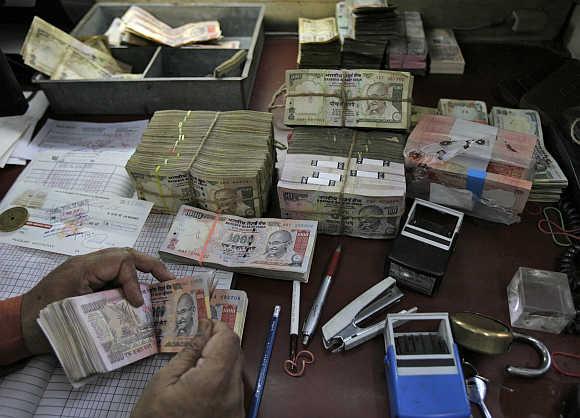 | « Back to article | Print this article |
Health of banks worsened in past six months: RBI
With stressed assets continuing to rise and expected to get worse, the Reserve Bank has cautioned that risks to the banking system have increased over the last six months, but added that there are no systemic risks at the moment.
"The banking stability indicator shows that risks to the banking sector have increased since June 2013," the Reserve Bank said in its half-yearly Financial Stability Report released on Monday.
The indicator combines the impact on all major risk dimensions, said the RBI, which has carried out multiple tests before coming to this conclusion.
"The strain on asset quality continues to be a major concern," the report said.
Click NEXT to read further. . .
Health of banks worsened in past six months: RBI
With the present conditions continuing, the gross non-performing assets in the system will rise to 4.6 per cent by September 2014 from 4.2 per cent in September 2013 or about Rs 2.29 trillion from Rs 1.67 trillion a year earlier, it said.
The amount of recast loans touched an all-time high of 4 trillion or 10.2 per cent of the overall advances as of September 2013, the report added.
However, the RBI expects some positives in the second half of the next fiscal and is estimating gross NPAs to improve to 4.4 per cent by March 2015.
In case the economic conditions deteriorate, the same number will be 7 per cent by March 2015, the RBI warned.
Click NEXT to read further. . .
Health of banks worsened in past six months: RBI
The state-run banks will be the worst-affected, the report said, pegging the GNPAs for public sector banks at 4.9 per cent by March 2015.
It projected the GNPAs for private banks at 2.7 per cent in the same period.
If the restructured assets are added, the total stressed advances ratio will rise to 10.2 per cent as of September 2013 from the 9.2 per cent in March 2013, the RBI said.
The report reiterates that RBI will discontinue the system of relaxed restructuring of advances from 2015 onwards and warned that state-run banks will be affected the most as the provisions will shoot up.
Click NEXT to read further. . .
Health of banks worsened in past six months: RBI
"The regulatory concerns regarding restructuring arises from the possibility of the relaxations not being used judiciously by banks commensurate with the viability of projects.
“These relaxations for asset classification/provisioning will be phased out by April 2015," it said.
The report said though agriculture accounted for the highest GNPAs at 5.5 per cent as of the quarter to September 2013, it is the industrial sector with a GNPA of 4.9 per cent and 10.9 per cent of restructured loans which is the main culprit.
Click NEXT to read further. . .
Health of banks worsened in past six months: RBI
Among the sectors, it said infrastructure, iron and steel, aviation, textiles and mining, which have not been doing well, will continue to perform badly.
"Some factors affecting the asset quality adversely are current economic slowdown -- global and domestic -- persistent policy logjams, delayed clearances of various projects, aggressive expansion by corporates during the boom phase with resultant excess capacities and deficiencies in credit appraisal," it said.
The central bank also said that present levels of provisioning for loan losses by banks may not be sufficient to meet the expected losses if the conditions were to deteriorate.




